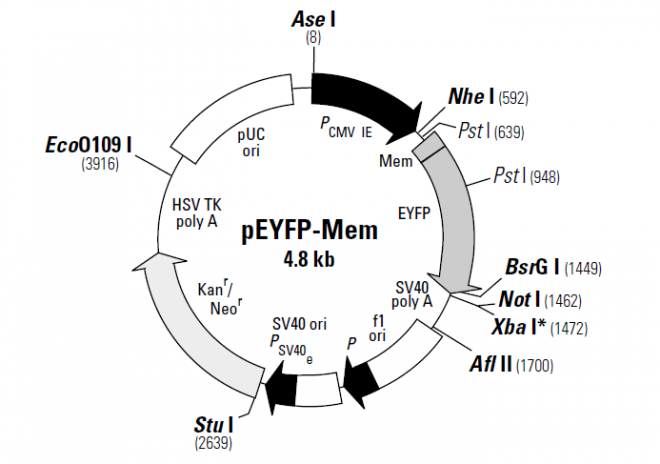pEYFP-Mem 载体
| 质粒类型: | 荧光蛋白报告载体 |
|---|---|
| 启动子: | CMV |
| 克隆方法: | 多克隆位点,限制性内切酶 |
| 载体大小: | 4.8kb (查看载体序列) |
| 载体抗性: | Kanamycin (卡那霉素) |
| 筛选标记: | 新霉素(Neomycin) |
载体说明
pEYFP-Mem encodes a fusion protein consisting of the N-terminal 20 amino acids of neuromodulin, also called GAP-43 (1), and a yellow-green fluorescent variant of the enhanced green fluorescent protein (EGFP). The neuromodulin fragment contains a signal for posttranslational palmitoylation of cysteines 3 and 4 that targets EYFP to membranes. The EYFP gene contains four amino acid substitutions previously published as GFP-10C (2). The fluorescence excitation maximum of EYFP is 513 nm, and the emission maximum is 527 nm (in the yellow-green region).
In addition to the chromophore mutations, EYFP contains >190 silent mutations that create an open reading frame comprised almost entirely of preferred human codons (3). Furthermore, upstream sequences flanking the EYFP-Mem fusion protein have been converted to a Kozak consensus translation initiation site (4). These changes increase the translational efficiency of the fusion protein and consequently its expression in mammalian cells.
Expression of EYFP-Mem is driven by the immediate early promoter of CMV (PCMV IE). The vector contains an SV40 origin of replication and a neomycin resistance (Neor) gene for selection in mammalian cells. A bacterial promoter upstream of this cassette (P) expresses kanamycin resistance in E. coli. The vector backbone also provides a pUC19 origin of replication for propagation in E. coli and an f1 origin for singlestranded DNA production.
载体应用
pEYFP-Mem can be transfected into mammalian cells using any standard method. If required, stable transformants can be selected using G418 (5). Expression of EYFP-Mem in mammalian cells results in strong labeling of the plasma membrane and allows easy tracking of individual cells in a population. This membrane labeling also permits study of fine cellular processes such as neuronal axons (6), leading edges of migrating cells, filopodia, or microvilli on cell surfaces. pEYFP-Mem cannot be used as an exclusive plasma membrane marker because it also partially labels intracellular membranes.


